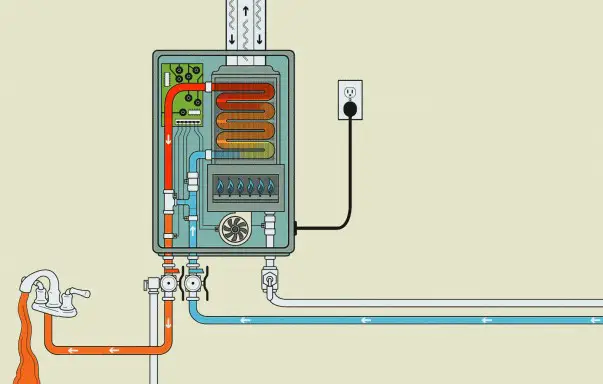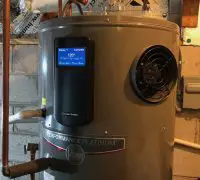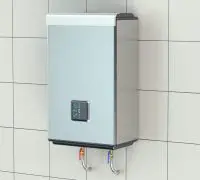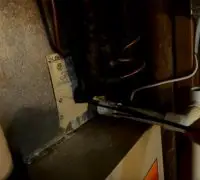If you're looking to fix or replace your Heating or A/C system, we can connect you with a reliable and cost-effective professional in your area.
There are many aspects for which you may have decided to switch to a tankless water heater. Some went tankless for the high energy efficiency, whereas others may have chosen them for the small and compact profile. No matter the reason, though, one thing is sure: tankless water heaters are a wise investment to make for your home.
Page Table of Contents
What aspects to notice when adjusting the temperature on your tankless water heater?
Several aspects affect the temperature of the water, and groundwater temperature is one of them.
It’s not only the number and kind of fixtures that you have to note when setting your tankless unit, but also the temperature of the groundwater. Where you live may impact significantly the performance of your tankless water heater, and it can rule it out from the beginning.
You should go online and check the charts about the groundwater temp in your area. The colder the groundwater is, the more difficult it will be for your unit to give hot water. It’s because it has to work harder, which may affect its performance altogether. For instance, a tankless water heater in Michigan would have to be 33 to 50% larger than in Florida for sustaining the same kind and number of fixtures.
A tankless unit will need to perform harder for warming the incoming cold water when it’s only 30F degrees. The situation is different when the groundwater temp is 72F degrees (in Florida).
How to find out the temperature rise?
The temperature rise results from the difference between the incoming cold water temperature and the temperature of your output water. When you want your shower to be 110F, and you live in Florida, the temperature rise will only be 38F degrees (110-72=38).
It’s essential to select a tankless water heater that has the flow rate and temperature rise appropriate for your living area. You only have to subtract the groundwater temperature from the wanted output temperature (scroll down for the details). Typically, you want 110-115F degrees for the water to be heated. When the groundwater temp is 60degrees, and you want the shower to be 110degrees, you need a 50-degree rise from the water heater.
The tankless units are sized by rating the temperature rise at a certain GPM. Therefore, a water heater may have a 33F temperature rise ad 2.0GPM. The same tankless water is probably able to ensure a 65F temperature rise at 1.0GPM. Needless to say, the slower the flow of water, the more water the unit can heat.
Is there a standard temperature for hot water from a tankless water heater?
Truth be told, there’s no such thing as ideal hot water, and your take on the temperature always has the final word. Like everything else in life, the perfect hot water depends on your home’s needs, the age of people in your family, with children, and the elderly being more sensitive to the high temperature of the water. Should anyone in your family suffer from compromised immune systems, the temperature for the hot water should be higher, though.
More often than not, the tankless water heaters come with the thermostat set at 140F degrees, which is the universal standard.
However, for most of the households, the temperature doesn’t have to be that high. You may quickly reduce it down to 120F degrees without even feeling the difference.
Setting the water heater to 120F degrees is safe, but also saves you a lot of energy and money. It’s a safe temp for children, and the risk for accidental burns is lower too.
When you’re turning down the thermostat to 120F degrees, you also protect the unit since the build-up of minerals inside will be significantly reduced. The risk for corrosion inside the heater’s elements and pipes will be lower when you’re not using the highest temperature setting on your water heater.
You may not be aware of it, but turning down the thermostat will save your energy bills of up to 5% for every 10 degrees.
Savings caused by turning down the temperature come from lower standby loses (heat loss from the unit into the surrounding environment) and consumption (from water demand in your house). When you set the temp at 140F degrees, the water heater will cost you $36-$61 every year in standby heat losses. It’s $400 in-demand losses, just that you know.
120F degrees is the most appropriate temperature setting for most households. As a matter of fact, the U.S. Department of Energy suggests that the 120F degree is the best for saving and maintenance purposes. As we’ve already mentioned, most tankless water heaters are automatically set to 140F degrees, but that’s not mandatory.
Is 140F degrees a safe setting?
In some situations, the 140F degrees is the recommended setting for your tankless water heater. For example, someone struggling with a suppressed immune system or chronic respiratory disease may benefit from 140F degrees setting. Moreover, the U.S Occupational Safety and Health Administration (OSHA) highlights that the setting of the 140F degrees reduces the chance for Legionnaires’ disease.
On top of everything else, dishwater that doesn’t come with a pre-heating function will perform better with a 140F degree setting on the tankless water heater.
How to prevent scalding hot water?
Should you decide that 140F degrees are the best temperature in your household, you could at least install a thermostatic valve for lowering the risk of scalding hot water.
The thermostatic mixing valves will establish a limit (it’s up to you) on the maximum water temperature that you allow to come out of the water heater.
Not only that the thermostatic valve reduces the risk of scalding, but it also improves the efficiency of the tankless water heater. The temperature is lower, and the water heater can provide more hot water for a longer time.
Instead of a conclusion
When you’re not sure about the temperature set on your tankless water heater, you only need to take a look at the dial. Not all tankless water heaters feature temperature dial, though. In this case, you can get a temperature reading from a faucet. You only turn the hot water all the way up, let it run for a couple of minutes, taking the temperature afterward.
We can definitely connect you with a trusted provider in your area to repair, replace or maintain your heating and A/C systems. Why not let us find a professional for you?






